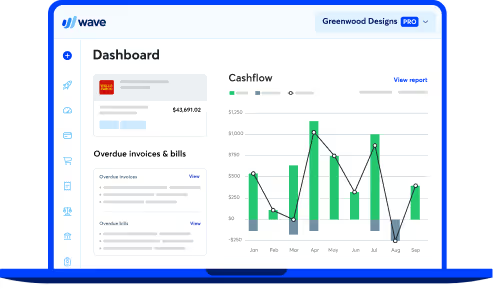
9 common cash flow problems and how to solve them
As entrepreneurs, we all have a fear of running out of money and having cash flow problems. The absence of a “predictable paycheck” is scary, but the rewards of owning your own business far outweigh those risks.
That’s not to say we should put this fear completely aside. In fact, a lack of finances is the second biggest reason businesses fail. But you don’t have to be a part of that statistic.
Paying attention to your cash flow and tackling challenges head-on is a great way to make sure you always have the funds you need to stay in business. Below, let’s look at how you can be proactive in maintaining healthy cash flow for your small business.
What is cash flow?
Cash flow is the blanket term for all of the money coming into and going out of your business. In financial terms, it’s the culmination of accounts receivable and accounts payable.
Think of it this way: Cash flow refers to the flow, or movement, of money both in and out. It’s not about sales or revenue, it’s about the actual, cold hard cash that is made available (or unavailable) to your business.
Cash flow is extremely important for small businesses. Even if you don’t consider yourself a “money person,” you will have to do some basic business accounting in your business. As an entrepreneur, you need to keep your eye on cash flow. If you don’t, you could find yourself in situations where you don’t have any money to continue operating your business.
To start, it’s helpful to consider some of the more common cash flow problems for SMBs and what you can do to mitigate them.
9 common cash flow problems
Late or partial payments
Outstanding payments are one of the biggest challenges SMBs face when it comes to cash flow. One study showed that 60% of invoices are paid late. This is a real cash flow problem because you’ve done the work, yet you haven’t received the money for it. Not only are you out the profit, but you’re also out whatever it cost you to complete the job.
More than 30% of SMBs are negatively impacted and spend an average of 15 days each year chasing payments alone.
According to this study, the smallest businesses wait an average of 72 days before their invoices are paid. That’s rough!
And if you offer partial payments, that also ties up your cash. Allowing your customers to pay in installments, especially for large purchases, is a smart strategy for driving sales. But it’s not great for your cash flow.
How to solve it:
- Get paid up front, even just a deposit can help.
- Send your invoices ASAP.
- Implement automated payment reminders on your invoices.
- Offer discounts for early payments and payments made in full — and charge a fee for late ones.
- Run a credit check on your customers first (this may not be applicable to all businesses).
- Provide multiple payment options.
- Sign up for a lockbox where customers and their banks can mail physical checks.
- Take proper steps to handle non-payments and similar issues
Sending invoices with online-enabled payments is a great way to ensure that your clients pay in-full and on-time. Check out the video below to learn more!
Not enough cash buffer on hand
A cash buffer is essentially a financial safety net for your business. To determine how much cash buffer your business needs, you’ll divide cash balances by cash outflows. This will tell you the number of days that your cash on hand will be able to make up for no incoming cash flow.
According to one JPMorgan Chase study, the average SMB has just 27 days of cash buffer on hand. This may vary depending on your business though, so it’s best to calculate your own cash flow to understand your business' unique situation.
How to fix it:
- Use the calculation provided above, or this cash flow calculator, to understand the appropriate cash buffer for your business.
- Renegotiate payment dates to your vendors and from your customers.
- Maintain and monitor a cash flow management spreadsheet.
Delayed payment posting
Just because you’ve received a payment doesn’t mean you have access to that money. With electronic payment processing, there’s often a delay between the time the payment was made and the moment the cash is accessible in your account(s).
This payment posting time is pretty much unavoidable, as that’s how banks work. But there are some ways you can plan for it and ensure your cash flow is stable.
How to solve it:
- Offer cash payment options.
- Incentivize cash payments with a discount or freebie.
- Connect your bank account to your invoicing software so customers can pay you via direct deposit, which may post more quickly.
- Open a line of credit to make purchases and preserve your cash on hand.
Disorganization
One study conducted by Staples found that three in four SMBs with struggling or failing businesses believe disorganization has led to a loss in productivity. And almost 40% aren’t “good with numbers.”
These are real challenges when it comes to maintaining healthy cash flow. You could go broke without even knowing it. If you’re not tracking, budgeting, planning, and forecasting, you could be in the dark about the true state of your business finances.
How to solve it:
- Create a statement of cash flow to predict surges and declines.
- Get a jump on next year’s taxes and start organizing your filing now.
- Implement a financial tracking tool like Wave so you can automate some of the processes and reduce the risk of human error.
- Use a receipt scanning app to take a picture of receipts with your phone and upload them to your account.
Rapid growth
If your business has grown quickly, congratulations! While that growth is great for your bottom line, you may also face some growing pains along the way, with cash flow being just one of them.
As you make more money, you also have to spend more money to run your business. Your overhead could increase because you’re outsourcing more, you need to hire more employees, you have to upgrade tech tools to higher plans, or you need to invest in more inventory upfront.
How to solve it:
- Implement a tech stack that can grow with you. Start by identifying your future business goals and determining your needs from there.
- Generate some forms of passive income to compensate for a reduced income stream, or even fund some of your other business growth.
- Only hire when you absolutely need to and do so one at a time (at least at first).
Sales challenges
Whether you overestimated your sales volumes or sales have inexplicably come to a complete halt, any time that incoming money slows down, your cash flow suffers. Sometimes this decline in sales is caused by external factors, like market fluctuations or even the weather for a brick-and-mortar business that relies on foot traffic.
Other times, you can look internally. Is your marketing not resonating? Maybe it’s your lead nurturing process that’s the issue. And in many cases, it’s a combination of both controllable internal challenges and unavoidable external ones that can work against your sales goals.
How to solve it:
- There are a number of ways to solve this issue; it really boils down to why you’re not seeing any sales. Online businesses might look at their Google Analytics or conversion software, whereas a freelance photographer might consider implementing a referral program with incentives.
- Check out our guide to small business marketing for more ideas.
Varied payment terms
When your incoming and outgoing cash flow doesn’t match up, this can lead to shortages (and major surpluses).
For example, in my digital marketing business, I have one client account for which I outsource a lot of work to various contractors. I invoice my client at the beginning of each month after the work has been done. My contractors’ billing terms are all different. Some invoice upfront while others do after the fact, and the frequency and timing vary too. I can always count on my accounts getting low the few days before I invoice my client each month.
How to solve it:
- In my case, I could create a separate bank account which only handles money for that client. This would also help me see over time how much this work is netting me.
- Renegotiate payment terms so everything is synchronized.
- Automate invoicing, bank transfers, and payroll to better align with the varied schedules.
Spending too much
While sometimes you need to spend money to make money, there’s also the issue of spending too much money. If you find your overhead is getting out of hand, it’s time to dig into where your biggest expenses are and how you can reduce (or even eliminate) them.
How to solve it:
- Automate repetitive tasks that you previously hired people to do.
- Map out a business plan and financial milestones you want to meet before you make different investments.
- Monitor your ongoing expenses and categorize them. See which ones are the highest and tackle ways to reduce those first.
- Go paperless. One study from MultiBriefs showed that businesses spend $80 per employee on paper each year.
Too much inventory
If you’re in retail or sell physical products, inventory is one of your biggest and most important assets. It’s how you generate more money. But the cost to produce each item is more than what you paid your supplier for it. There are holding costs associated with keeping stock on hand.
Having safety stock is important to retail operations and avoiding costly stockouts, but if you have too much on hand, this can actually have a harmful effect.
How to solve it:
- Improve your forecasting with integrated inventory management software and point-of-sale system.
- Only order what you truly need. Here’s how to find out your ideal safety stock level:
(Maximum daily usage X Maximum lead time in days) – (Average daily usage X Average lead time in days)
- Implement auto-reorder and purchase order processing.
- Make sure you account for marketing and advertising campaign budgets and order merchandise accordingly.
Moving forward with curbing your cash flow problems
One of the goals of being an entrepreneur is to make money. But you can still make money and go broke. It just takes some planning and proactive thinking to make sure you maintain healthy cash flow, curb any cash flow problems, ultimately stay in business.
(and create unique links with checkouts)
*While subscribed to Wave’s Pro Plan, get 2.9% + $0 (Visa, Mastercard, Discover) and 3.4% + $0 (Amex) per transaction for the first 10 transactions of each month of your subscription, then 2.9% + $0.60 (Visa, Mastercard, Discover) and 3.4% + $0.60 (Amex) per transaction. Discover processing is only available to US customers. See full terms and conditions for the US and Canada. See Wave’s Terms of Service for more information.
The information and tips shared on this blog are meant to be used as learning and personal development tools as you launch, run and grow your business. While a good place to start, these articles should not take the place of personalized advice from professionals. As our lawyers would say: “All content on Wave’s blog is intended for informational purposes only. It should not be considered legal or financial advice.” Additionally, Wave is the legal copyright holder of all materials on the blog, and others cannot re-use or publish it without our written consent.


























